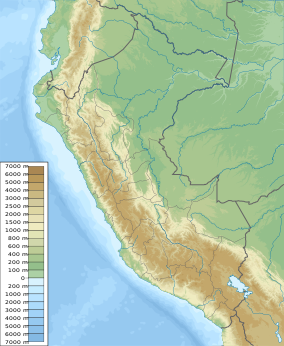Pampa Hermosa National Sanctuary
| Pampa Hermosa National Sanctuary | |
|---|---|
| Location | Junín Region |
| Coordinates | 11°02′12″S 75°28′50″W / 11.03667°S 75.48056°W |
| Area | 11543,74 ha |
| Established | 2005 |
| Governing body | SERNANP |
Pampa Hermosa National Sanctuary (Spanish: Santuario Nacional Pampa Hermosa) is a protected area in Peru located in the region of Junín.[1] It preserves one of the last pristine areas of montane forests in central Peru.[1]
Geography
[edit]Pampa Hermosa National Sanctuary is located between the provinces of Tarma and Chanchamayo, in the region of Junin, Peru.[2] The area is mountainous, with an elvational range between 1340 and 3960 m.[2]
Ecology
[edit]Pampa Hermosa protects areas of tropical montane rainforests and high elevation grasslands.[2]
Flora
[edit]Plant species found in this protected area include: Cedrela angustifolia, Juglans neotropica, Retrophyllum rospigliosii, Iriartea deltoidea, Weinmannia sp., Escallonia myrtilloides, Pseudolmedia rigida, Alnus acuminata, Prumnopitys montana, Guarea guidonia, Styrax andinus, etc.[1][3][2]
Fauna
[edit]Animal species found in this protected area include: the Andean cock-of-the-rock, the Junín red squirrel, the yellow-throated toucan, the spectacled bear, the semicollared hawk, etc.[1][2]
References
[edit]- ^ a b c d "Pampa Hermosa - Servicio Nacional de Áreas Naturales Protegidas por el Estado". www.sernanp.gob.pe (in European Spanish). Retrieved 2018-11-14.
- ^ a b c d e Santuario Nacional Pampa Hermosa. Diagnóstico - Plan Maestro 2012-2017. SERNANP. 2014. ISBN 978-612-4241-01-7.
- ^ La Torre-Cuadros, María De Los Ángeles; Herrando-Pérez, Salvador; Young, Kenneth R. (2007). "Diversity and structural patterns for tropical montane and premontane forests of central Peru, with an assessment of the use of higher-taxon surrogacy". Biodiversity and Conservation. 16 (10): 2965–2988. doi:10.1007/s10531-007-9155-9. ISSN 0960-3115. S2CID 40800425.

